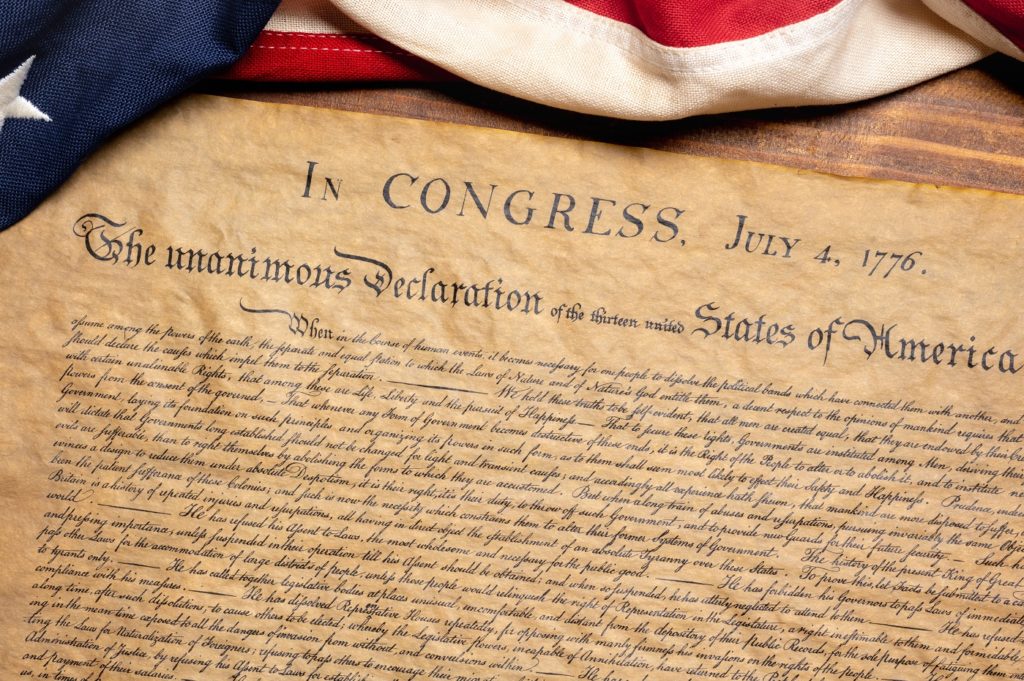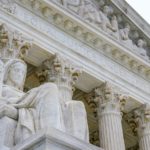John Grove of Law & Liberty has written the most thoughtful critique of common good originalism—the jurisprudential framework I have developed over the past year-plus, including here at Public Discourse and most recently in a long-form Harvard Journal of Law & Public Policy (HJLPP) essay—to date. Grove has proven himself to be a relentless critic of a more substantively and morally informed jurisprudence. In his Public Discourse essay, he takes direct and specific aim at common good originalism. His serious essay deserves a serious response.
It is first worth noting that Grove and I agree on more than he seems to realize. In the essay, Grove repeatedly emphasizes that ours is a “compromise constitution” that “emerged from a negotiated consensus,” such that we ultimately “have few guides” in interpretation other than “the text [all relevant bodies] ratified.” I concur in this general reading of the relevant history. However, in my view, that history cuts in precisely the opposite direction of the one Grove seems to think it does.
It is no great secret that the Founders vehemently disagreed among themselves on virtually everything, up to and including the very nature of the American Revolution itself—that is, whether it was a true liberal “revolution” in the Enlightenment rationalist sense of the term (the position of Thomas Jefferson, Thomas Paine, and their allies) or whether it was more accurately understood as a conservative “restoration” of the common law rights of Englishmen that Parliament and the Crown had begun to deny to the American colonists in the aftermath of the Seven Years’ War (the position of Alexander Hamilton, John Adams, and their allies). Many of the relevant debates, including the drafting debates at the 1787 Constitutional Convention and the great constitutional interpretive debates during the first few Congresses, such as the 1793-1794 Pacificus-Helvidius Debates between Hamilton and James Madison, must be understood as intellectually downstream of this overarching, higher-order philosophical disagreement.
The upshot is that many key constitutional clauses were indeed drafted as compromise provisions intended to win over the greatest number of prospective ratifiers among intensely warring intellectual and political tribes. When combined with the insight that many of these clauses, such as Article I, Section 8’s General Welfare Clause and Necessary and Proper Clause, are written in unmistakably broad, sweeping language, this ought to cut strongly in favor of a dispositional humility about an interpreter’s ability to definitively discern the most accurate original meanings of at least some of these clauses.
Start your day with Public Discourse
Sign up and get our daily essays sent straight to your inbox.This is a quintessentially Burkean argument. As I argue in the HJLPP essay, it should lead us to accept that, in many instances, there is a broader array of non-frivolous, plausible originalist interpretations than some overly confident, triumphalist, historicist originalists are usually comfortable conceding. In general, a higher level of linguistic generalization should push interpreters toward greater epistemological humility. This is especially true when those linguistic generalizations as expressed in a legal document’s final text were themselves the result of fraught compromise.
Many key constitutional clauses were indeed drafted as compromise provisions intended to win over the greatest number of prospective ratifiers among intensely warring intellectual and political tribes.
The key question is what an interpreter ought to do when he is faced with a text that admits of multiple plausible originalist interpretations. Positivist/historicist originalists tend to answer this question in at least one of two non-mutually exclusive ways. Some resist my Burkean appeal to interpretive humility, arguing on the contrary that we now possess the linguistic research tools that enable us to ascertain a clause’s “one, true, authentic historical meaning.” Others—such as Grove, it seems, and perhaps also Ed Whelan—forthrightly acknowledge the difficulties presented by the abstract phrasing and sweeping language of certain constitutional provisions, but maintain nonetheless that the only legitimate approach is to eschew all non-historicist considerations and simply do one’s exegetical “best” to determine the historically “right” answer.
My fairly modest claim is that, in these situations of reasonable interpretive ambiguity, judicial and political statesmen instead ought to err on the side of what I call the telos of the American regime. This telos is most clearly expressed in the Constitution’s common good-oriented Preamble, though the Declaration of Independence is of course also relevant. This approach would seem to accord with the sentiments expressed by both Hamilton and Madison, arguably the Founding generation’s two most formidable legal luminaries. Hamilton begins The Federalist No. 31, for instance, with the following: “In disquisitions of every kind, there are certain primary truths, or first principles, upon which all subsequent reasonings must depend.” And Madison in The Federalist No. 57 argues that “[t]he aim of every political constitution is, or ought to be, first to obtain for rulers men who possess most wisdom to discern, and most virtue to pursue, the common good of the society.”
My fairly modest claim is that, in these situations of reasonable interpretive ambiguity, judicial and political statesmen instead ought to err on the side of what I call the telos of the American regime. This telos is most clearly expressed in the Constitution’s common good-oriented Preamble, though the Declaration of Independence is of course also relevant.
Grove ignores this overarching context entirely. Instead, he presents a straw-man version of my stance on the nature of the Preamble. He writes that I suggest that the Constitution is “defined by… an ideal” of “discretionary, common good-oriented statesmanship.” A more accurate description would be that I believe the constitutional text is necessarily oriented toward certain substantive ideals of natural justice, human flourishing, and the common good, and that the Preamble serves as a particularly clear and compelling citation to ground that claim.
Furthermore, my stance is not that “a small, likeminded cadre of Founders” steered the entire direction of the Convention. Rather, I argue that the very “compromise” nature of the Constitution imbues some of the text with a degree of interpretive uncertainty, thus sometimes necessitating an appeal to something else for guidance. This is indeed precisely what Blackstone means when he writes that “for since in laws all cases cannot be foreseen or expressed, it is necessary” in cases of ambiguity or “dubious[ness]” to channel the ratio legis, or reason of the law. That the Constitution was ultimately ratified by the various state conventions, and not necessarily the specific men present at the Philadelphia convention of 1787, hardly seems relevant to the debate over the propriety of an interpretive invocation of Blackstonian ratio legis, despite Grove’s fixation on the distinction.
And while our Constitution was a distinct compromise, Grove also severely downplays the extent to which the more nationalist, common good-oriented originalism of Hamilton and his Federalist Party contemporaries was indeed championed and vindicated by some of the early republic’s greatest judges and most influential statesmen. Grove doesn’t so much as mention either Chief Justice John Marshall or his landmark McCulloch v. Maryland (1819) opinion, in which the greatest chief justice in Supreme Court history famously endorsed Hamiltonian nationalism on the Necessary and Proper Clause:
Let the end be legitimate, let it be within the scope of the constitution, and all means which are appropriate, which are plainly adapted to that end, which are not prohibited, but consist with the letter and spirit of the constitution, are constitutional.
The closest current Supreme Court justice that Jeffersonian “strict constructionists” might conceivably claim as an heir, Clarence Thomas, expressly endorsed Marshall’s ruling in his Sabri v. United States (2004) concurrence, opining that Marshall “carefully and effectively refuted” the Jeffersonians’ preferred strict “absolute necessity” construction. The great Justice Joseph Story, a staunch nationalist and adamant proponent of public morality—and thus another de facto common good originalist—is nowhere to be found in Grove’s essay. Ditto Abraham Lincoln, the greatest nationalist statesman in American history and the republic’s most prominent advocate of a substantive, natural justice-oriented statesmanship—especially when contrasted with the proposed alternative of bare-bones proceduralist positivism, as advanced by Lincoln’s rival Stephen Douglas. These post-Constitutional Convention omissions from Grove’s historical narrative are telling.
Finally, and I don’t begrudge Grove here because I’ve been less than clear on this in past essays, it is not necessarily my contention that the Preamble was understood at the time of the Convention to be an authoritative guide or lens through which to interpret the constitutional text. Rather, my claim is that the Preamble—as is often the nature of preambular language in other written contexts, such as statutes and contracts—articulated a broader purposive orientation of the American constitutional order and republic toward principles of natural justice and the commonweal, especially when those principles are weighted against extremist (even caricaturable) claims of “liberty”- or autonomy-maximizing positivist legal construction.
That broader regime orientation was naturally, perhaps even implicitly, channeled and implemented by many of the republic’s most iconic statesmen. Again, a quintessential political example would be Lincoln’s repeated emphasis on the imperative to side with natural justice and human flourishing for antebellum blacks, which contrasted with Douglas’s hollow proceduralist pleas for “popular sovereignty” in the Western territories that redounded to the property “liberty” of slaveholders. We can easily see how the exact same principle applies, this time in a juridical context, in the recent Fourteenth Amendment abortion debate between John Finnis and Whelan. The upshot is that moral truth cannot possibly be severed from constitutional conservatism, and the strongest forms of purist textualism—such as what it seems Grove advocates—fundamentally fail to grasp that.
In sum, Grove has written a thoughtful and sophisticated critique of common good originalism—certainly the most thoughtful and sophisticated critique thus far. But in focusing so much on Convention-era historicism and ignoring the broader substantive context of the American constitutional order, Grove’s tactical choices of inclusion and elision in his essay serve as an ironic microcosm for the methodological maladies of positivist/historicist originalism itself.














